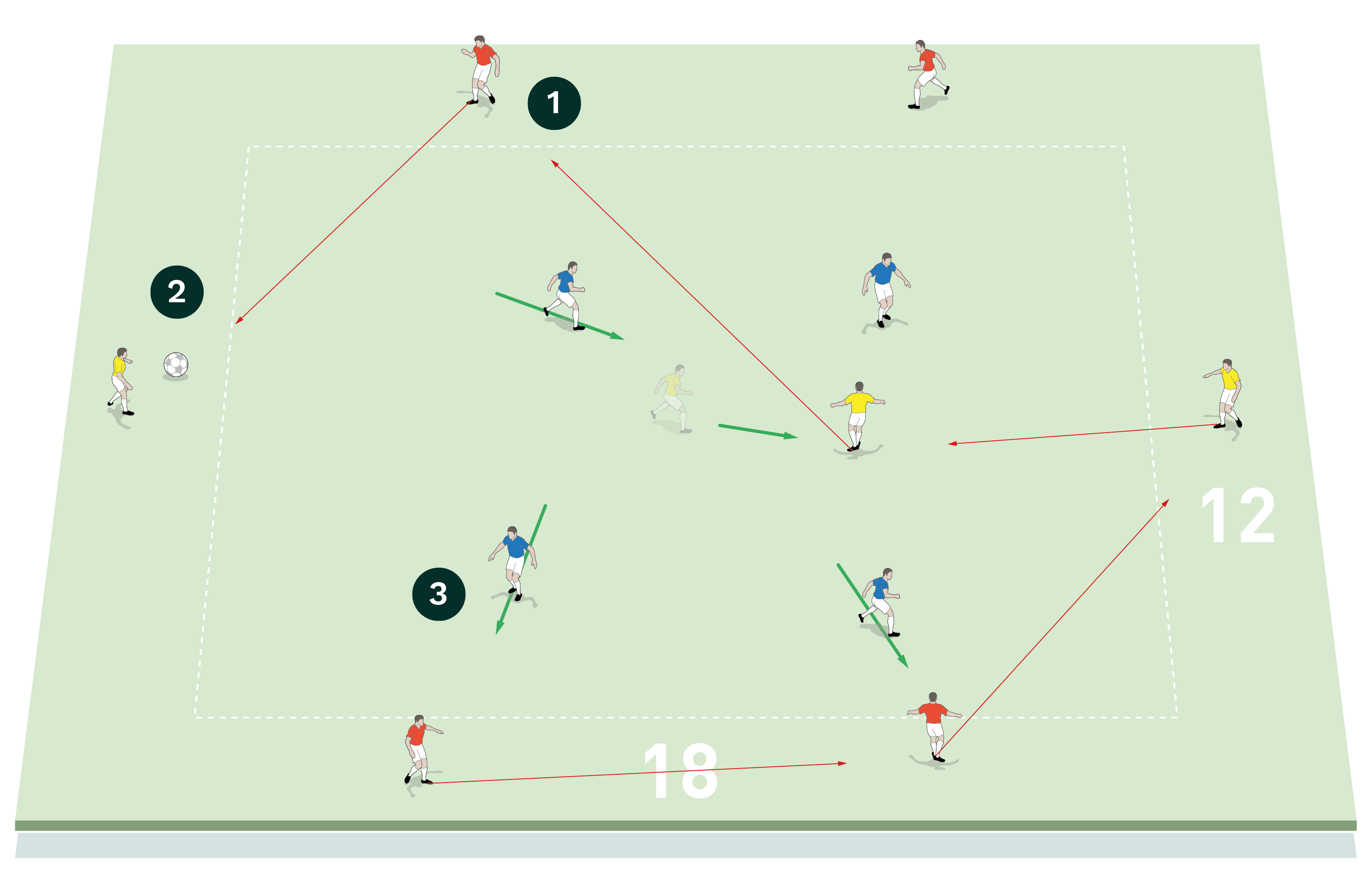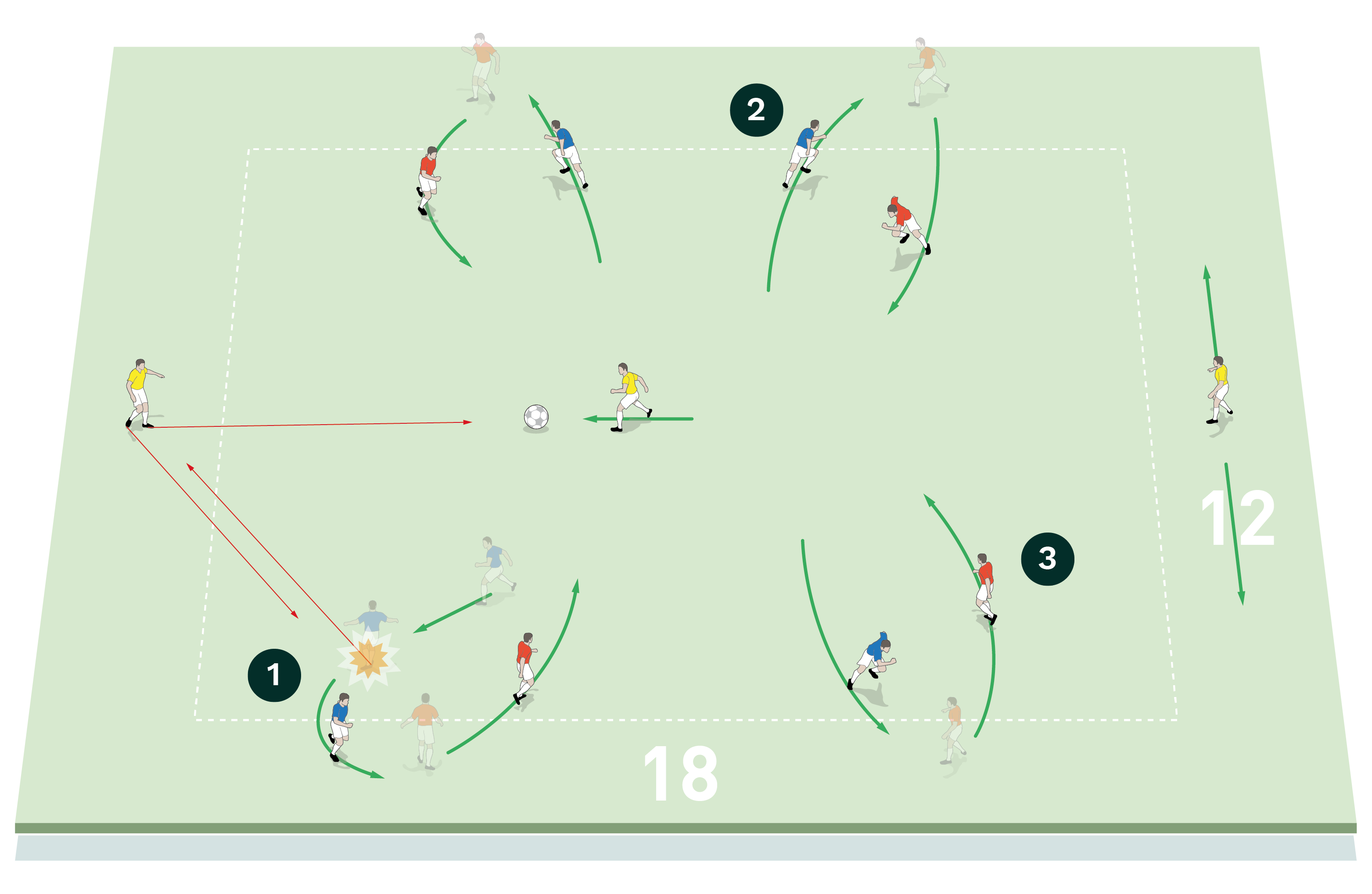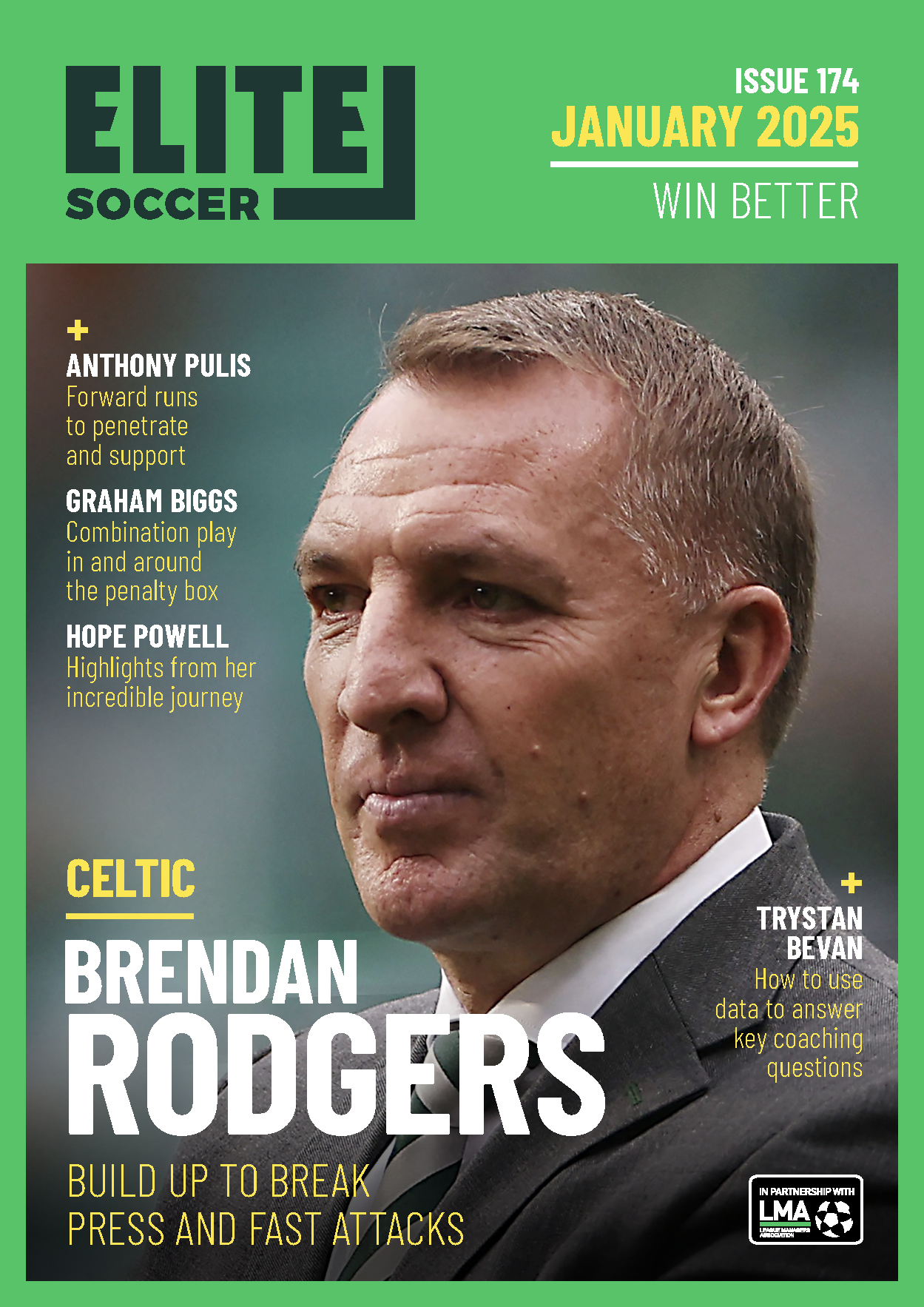You are viewing 1 of your 1 free articles
Pressing triggers when out of possession
| Area | Up to full pitch |
| Equipment | Balls, bibs, cones, 8 mannequins or poles, 2 full size goals |
| No. of Players | Up to 20 players + 2 goalkeepers |
| Session Time | Possession 4v4+3: 8mins 10v10 possession with goalkeepers: 14mins 11v11 game: 14mins |
This session focuses on pressing triggers and shows players how and when to press in certain scenarios from a compact shape.
We want to see that players have a positive mentality when pressing the ball from a compact shape. Understanding when, where and how to press to win the ball back and score is the main aim of the session.
Players need to be able to spot the right time to press and to recognise and exploit a bad touch from the opposition or capitalise on a switch of play. The specific roles and responsibilities of each player in the press are very important.
We would run this session once a week, two days before a match. The shape of our upcoming opponents
would dictate which shape we would play against in the session.
“Understanding when, where and how to press to win the ball back and score is the main aim”
POSSESSION 4v4+3
We set up a playing area of 18x12 yards. We’re using 11 outfield players split into two teams of four and one team of three. The red team of four starts with two players on either side of the playing area and they must pass the ball to keep possession, while the blue team of four starts inside the playing area and they must press to win possession.
The neutral yellow team of three has a player at each end and a player in the centre of the playing area. The three yellows play for the team in possession, combining to make it a 7v4 situation to keep the ball, as shown [1a].
If the blue pressing team of four wins the ball back successfully they aim to find a pass to a neutral yellow player as quickly as possible in transition.
[1a]

2. The three yellow neutrals play for the team in possession and must help them keep the ball, making it a 7v4 situation
3. The four blue players aim to press and win the ball back whenever possible
[1b]

2. After winning possession, the blues switch roles with the reds as quickly as possible. The blues move to positions on the outside of the area and replace the reds
3. The red players now move into the middle to press the ball
If this happens, the blue and red teams change roles quickly – the blue players now move to positions on the outside of the area and replace the red players, who move into the middle to press the ball, as shown [1b].
The key details we want to see are players making the quick transition to pressing after losing possession and they must demonstrate that they are aware of the pressing triggers.
We play three games of two minutes.
“We want to see players making the quick transition to pressing after losing possession and they must demonstrate they are aware of pressing triggers”
10v10 POSSESSION WITH GOALKEEPERS
We set up a playing area of 52x58 yards on the centre of the pitch and position four mannequins at each end. An additional scoring zone is marked out at each end.
We’re using 20 outfield players and two goalkeepers split into two teams of 11. Both teams are set up in a 3-5-2 formation inside the central playing area with a goalkeeper positioned at each end on the edge of the scoring zone.
Play starts with a pass out from the back into the playing area by one of the goalkeepers. The aim for the team in possession is to attack the opposite end and arrive in the scoring zone behind the four mannequins with the ball under control to gain a point. As the possession team attacks, the defending team aims to set pressing triggers to win the ball back and the team must press together as a unit, as shown [2a].
If the pressing team wins the ball then the aim is to try to score a point in transition by counter-attacking the end scoring zone, as shown [2b].
We play two games of six minutes.
[2a]

2. The blues start play as the defending team. They are set up in a 3-5-2 formation and aim to set pressing traps to win the ball back
3. The blue team must press together as a unit
[2b]

2. The attacker on the ball has to decide whether to dribble into the scoring zone or to play a forward pass for a team mate to run onto to receive the ball under control in the end scoring zone
11v11 GAME
We set up on a full size pitch with a full size goal at each end. This allows us to test the players in a realistic scenario.
We’re using 20 outfield players and two goalkeepers split into two teams of 11. The session now progresses to an 11v11 game, with one team set up in a 3-5-2 formation and the other team set up in the formation used by our forthcoming opponents, as shown [3]. The idea now is to implement specific pressing triggers that were worked on in the previous activities. A goal scored as a result of a pressing trigger is rewarded with an extra point.
We play two games of six minutes with minimal interventions.
“It is important to give players a clear understanding of the pressing triggers and pressing distances to engage the ball”
[3]

2. Work on specific pressing triggers in relation to the previous practice. Here the blues press as a team to win the ball back
COACHING POINTS
What are the key things to look for?
Managing the opposition is an important part of this practice. The opposition needs to make it realistic and really try to play through our compact shape to make the session work. We would normally have another coach managing the opposition to get the realistic outcomes from the session.
The players must be able to answer the following questions after working on the session: When do we press? Which area of the pitch are we forcing them into and why? Who presses the ball and how? What is a pressing trigger? What do we do when we win possession of the ball?
What are the typical mistakes players might make and how do I avoid them?
The typical mistake players make includes pressing when the distances are too big and therefore they press alone and are isolated.
Pressing on the wrong trigger is also a common mistake. To remedy this, it is important to give players a clear understanding of the pressing triggers and pressing distances to engage the ball, as well as making them understand that they have to put active pressure on the ball.
Related Files
Editor's Picks
Using the goalkeeper in build-up play
Pressing principles
Intensive boxes drill with goals
Penetrating the final third
Creating and finishing
My philosophy
Pressing initiation
Compact team movement
Defensive organisation
Coaches' Testimonials

Alan Pardew

Arsène Wenger

Brendan Rodgers

Carlos Carvalhal

José Mourinho

Jürgen Klopp

Pep Guardiola

Roy Hodgson

Sir Alex Ferguson

Steven Gerrard
Coaches' Testimonials

Gerald Kearney, Downtown Las Vegas Soccer Club

Paul Butler, Florida, USA

Rick Shields, Springboro, USA

Tony Green, Pierrefonds Titans, Quebec, Canada
Join the world's leading coaches and managers and discover for yourself one of the best kept secrets in coaching. No other training tool on the planet is written or read by the calibre of names you’ll find in Elite Soccer.
In a recent survey 92% of subscribers said Elite Soccer makes them more confident, 89% said it makes them a more effective coach and 91% said it makes them more inspired.
Get Monthly Inspiration
All the latest techniques and approaches
Since 2010 Elite Soccer has given subscribers exclusive insight into the training ground practices of the world’s best coaches. Published in partnership with the League Managers Association we have unparalleled access to the leading lights in the English leagues, as well as a host of international managers.
Elite Soccer exclusively features sessions written by the coaches themselves. There are no observed sessions and no sessions “in the style of”, just first-hand advice delivered direct to you from the coach.









